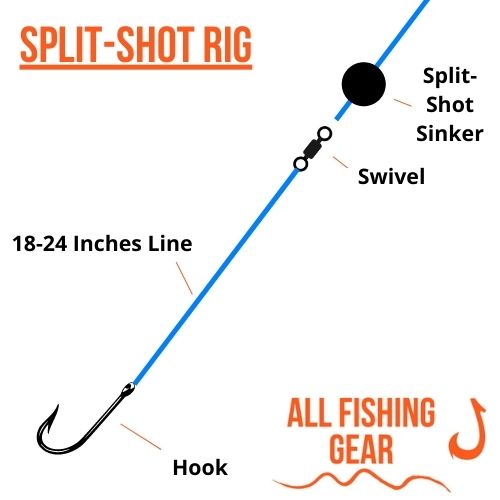The split-shot rig is one of the longest-standing bass fishing methods that has been used by anglers for decades to catch fish in a number of different situations. Many anglers have mostly abandoned the split-shot rig in favor of more modern approaches like a shaky head or even a drop shot rig. However, you’d do yourself a big favor by refreshing yourself on this tried-and-true method of catching fish.
The split-shot rig can be used virtually at any time of the year to catch fish in shallow or deep water. If you learn how to properly use it and are able to incorporate the split-shot in your upcoming fishing ventures, you’ll be filling your limit with more ease than ever before.
Table of Contents
What is the Split-Shot Rig?
A split-shot rig is a very simple way to fish that consists of three items including a small split-shot sinker, a hook and the soft plastic bait you want to use. Some anglers might know this one as the Mojo rig, but it works the same in either case and is probably one of the most simple and easy-to-rig lure presentation methods you can use.
To tie on a split-shot rig, you simply need to tie your hook on the line. Most anglers will use a split-shot or drop shot hook, but others usually opt for an offset shank hook or any other style they want to use in 2/0 or 3/0 size. There truly isn’t a type of hook that would be wrong for the split shot.
After tying the hook on, you then place your split-shot sinker on the line anywhere from about 18 to 24 inches above your hook. Some anglers might prefer to place their split-shot sinker farther ahead or closer to the hook, depending on the specific way they want to fish this rig, but generally, 18-24 inches is best.
Finally, you’re now ready to place the soft plastic bait on your hook. You’ll usually want to set the bait on the hook in the same way you would for any other Texas or Carolina style rig with the hook buried into the worm or creature bait.
There are many different types of soft plastic baits you can select that will work with a split-shot rig and you might want to experiment with different kinds to figure out what the fish want at any given time or place.

How to Fish a Split-Shot Rig?
The split-shot rig is a finesse approach, so it’s best fished with a spinning rod and reel to get the best results. I like to rig my split-shots with anywhere from 6 to 10 pound test monofilament or fluorocarbon fishing line. I will use a heavier 10 pound test line if I’m fishing around any structure where the rig might get snagged, but the split-shot rig is weedless, meaning you’re able to fish it into areas where other rigs might not work.
The split-shot rig is usually best with a 6 to 7-foot medium, fast-action spinning rod. Having a rod that gives you great sensitivity is ideal for using the split shot since the key to this rig is being able to feel the bottom and also to feel any fish biting.
When you cast the split-shot rig into the water, let it sink all the way to the bottom, whether you’re fishing in water that’s 5 feet deep, or water that’s 30 feet deep. Once it hits the bottom, you’ll want to reel up the slack in your line and begin slowly dragging it along the bottom. It’s important that you maintain constant contact between the sinker and the bottom so you’re able to feel any bites that occur as you drag it along.
You can vary the speed at which you drag the split-shot along the bottom, but the most crucial part of fishing this rig is making sure it maintains contact with the bottom and that you’re keeping your line tight to be able to detect any strikes.
When to Use a Split-Shot Rig?
The split-shot rig is great for virtually any time of the year, but it truly shines at times when bass are being more sluggish and tight-lipped. This might be during the dead of winter or the middle of summer when the fish are mostly in deep water around structure like docks, brush piles and other areas that are hard to fish.
I like to fish the split shot along any type of depth change like ledges, drop-offs, or especially creek channels and structure like timber or rocks. This rig works very well for fishing in early spring around primary and secondary points when bass are moving into shallow water from the deep areas where they’ve held up all winter.
Conclusion
There are no limits to the different soft plastic baits you can use with the split-shot rig. Some anglers have great success with finesse worms while others might use different creature baits that are seldom fished. The split-shot rig is one that’s great for beginner or novice anglers to start out using in order to allow them to understand how to ‘feel’ their way along the bottom while they fish with a weighted rig.
In any case, the split-shot rig is one that is an old favorite and should certainly be something you prepare to use when the bite is a bit slow.
